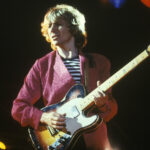Guitar tablature, affectionately known as “guitar tabs,” is a revolutionary method of musical notation that empowers aspiring guitarists to learn songs with remarkable speed and ease. While sharing common ground with traditional music staff notation in conveying notes, rhythm, and techniques, guitar tabs offer a distinct advantage, especially for beginners: they visually represent where to play notes directly on the guitar fretboard.
This direct representation is incredibly beneficial because the guitar fretboard allows for multiple locations to play the same note. Therefore, grasping guitar tablature and learning how to read guitar tabs unlocks the door for beginners to start playing music immediately, even without prior knowledge of standard musical notation.
At guitarplayers.net, we champion learning to read guitar tablature as a fundamental skill. Guitar tabs effectively display both chords and single notes, making them an efficient pathway to mastering your favorite songs. The beauty of guitar tabs lies in their accessibility – understanding them requires no specialized musical background beyond knowing the strings and frets of your guitar.
If you’re eager to demystify guitar tabs and explore their potential, you’ve landed in the perfect spot. Let’s embark on this exciting journey together.
WHAT IS GUITAR TABLATURE?
Guitar tablature is essentially a visual map of music for guitar. A standard guitar tab is composed of six horizontal lines, each representing one of the six guitar strings. When deciphering guitar tabs, you read them from top to bottom. The topmost line corresponds to the high E string (the thinnest), followed by lines for the B, G, D, A, and low E strings (the thickest).
This arrangement mirrors the perspective you have when looking down at your guitar in playing position. Think of guitar tablature as your personal roadmap, guiding you on the quickest route to playing guitar songs.
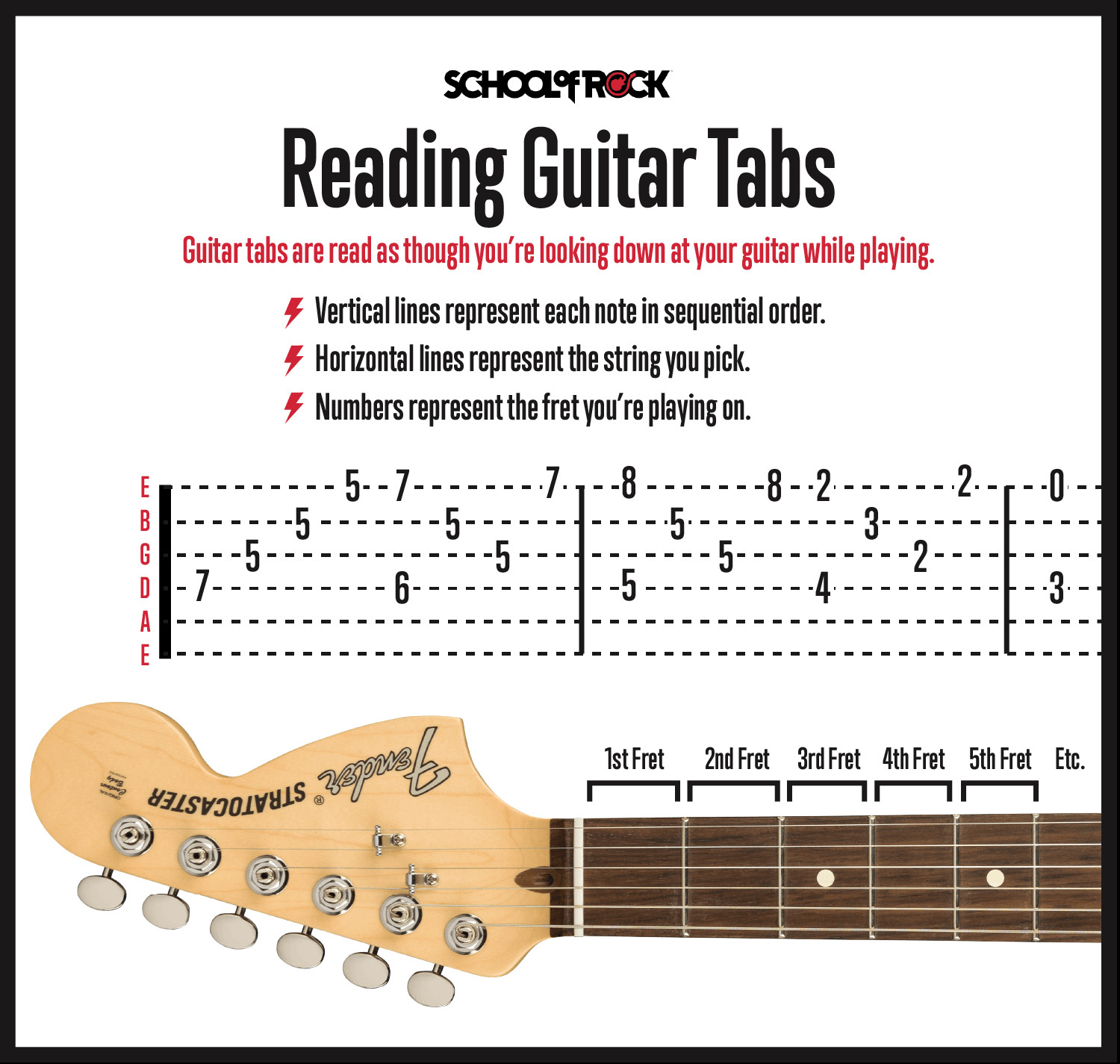 Guitar Tablature Explained: Visual Representation
Guitar Tablature Explained: Visual Representation
Within the guitar tab, you’ll notice numbers placed on these lines. These numbers indicate the fret numbers on your guitar. Frets are the metal strips along the fretboard, numbered 0-24, starting from the nut (closest to the headstock) and extending down the neck.
A ‘0’ on a string means you play that string “open,” meaning without pressing down any fret with your fretting hand. A ‘1’ signifies playing at the first fret. When learning how to read guitar tabs, it’s crucial to remember that ‘1’ represents the first fret, ‘2’ the second, ‘3’ the third, and so on up the guitar neck.
HOW TO DECIPHER GUITAR TABS: Reading from Left to Right
Guitar tablature is read linearly from left to right, with notes appearing in chronological order. When numbers are stacked vertically, they represent a chord. A chord is played by strumming all the indicated strings simultaneously. Guitar tab notation is often more intuitive for beginners compared to standard notation because it directly shows you which notes to play to form a chord and, crucially, where to locate those notes on the guitar.
Essential Knowledge for Reading Guitar Tabs
To effectively read guitar tabs, beginners should first become familiar with the names and order of the 6 guitar strings and the physical layout of the frets on the fretboard. This foundational knowledge will enable you to quickly translate the tab’s instructions into finger placements and produce the correct notes.
UNDERSTANDING THE TAB STAFF: Strings, Not Notes
The guitar tab staff visually resembles the staff used in standard music notation. However, a key difference is that the lines in guitar tab represent the 6 guitar strings, not musical pitches themselves.
The top line is the high E string, and the bottom line is the low E string. This direct string representation significantly simplifies the learning curve for beginners when learning how to read guitar tabs. The staff will typically be labeled “TAB” to avoid confusion with standard notation.
NAVIGATING GUITAR FRETS: The Numbered System
Guitar frets, the metal strips spanning the fretboard, are the key to pitch variation on the guitar.
Most guitars feature between 19 and 24 frets. Each fret represents a semitone, or half step, in pitch. Within each octave, there are 12 semitones. Most guitars incorporate fret markers, often dots or inlays, at the 3rd, 5th, 7th, 9th, and 12th frets. These markers serve as visual aids for quickly identifying fret positions during playing.
Remember, in guitar tabs, numbers denote fretted strings, while “0” indicates an open string. Playing an open string means plucking or picking the string without pressing down on any fret, allowing it to resonate freely.
UNLOCKING GUITAR TAB CHORDS: Vertical Alignment
Guitar chords in tablature don’t have unique symbols, but they are easily identifiable by their vertical arrangement. When several numbers are positioned directly above each other in a tab, they are intended to be played together as a chord. Even if a chord is arpeggiated (played one note at a time), the tab will show the notes sequentially, even though you are still holding the chord shape.
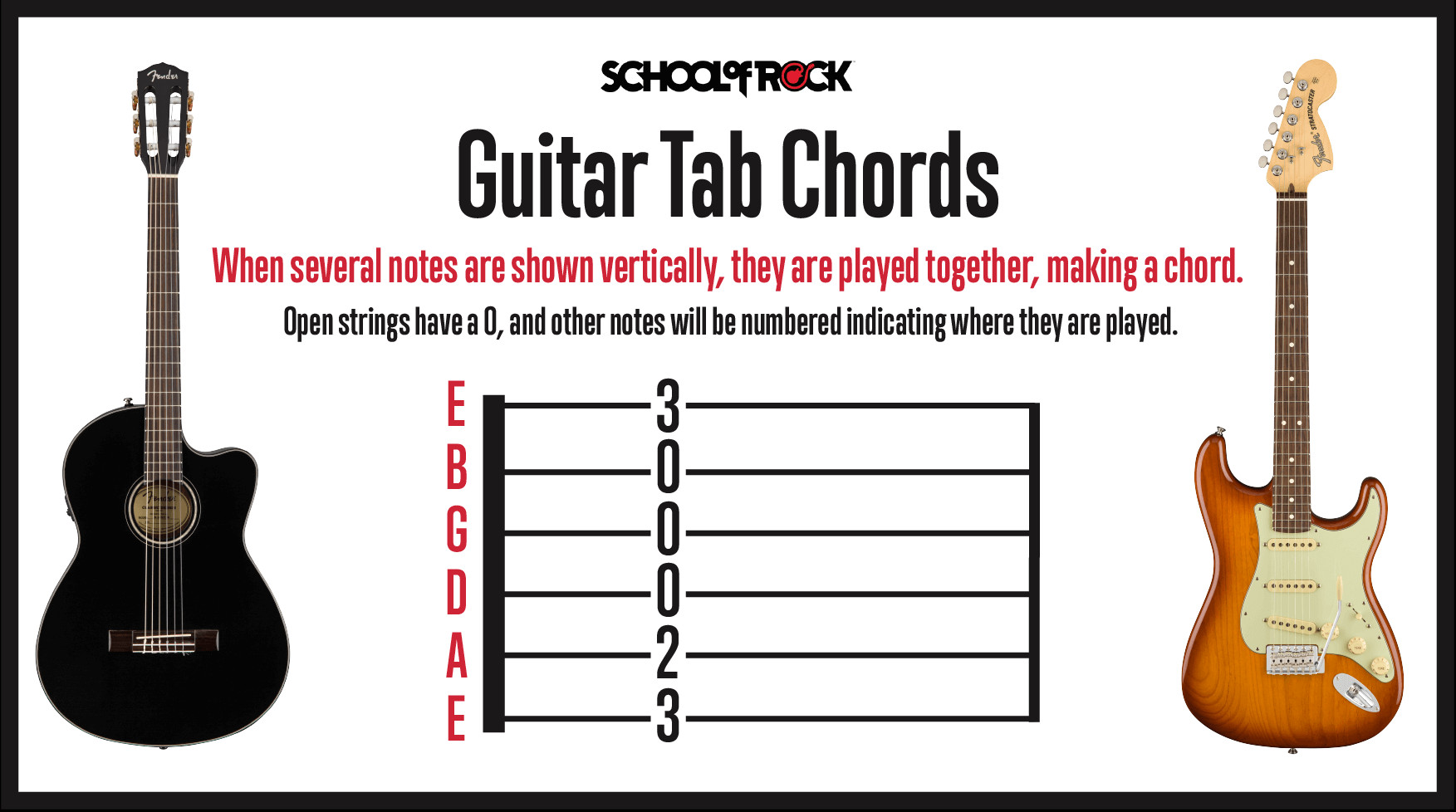 Reading Guitar Tab Chords: Vertical Note Alignment
Reading Guitar Tab Chords: Vertical Note Alignment
DECIPHERING GUITAR TAB RIFFS: Melodic Phrases
Many rock songs are built upon “riffs,” which are short, repeating musical phrases. Riffs typically blend single notes and partial chords, like power chords. When reading riffs in guitar tabs, the same principle applies: vertically aligned notes are played simultaneously. This consistent approach makes learning how to read guitar tablature efficient and straightforward, even when tackling more complex musical parts.
GUITAR TABS VS. CHORD CHARTS: Understanding the Differences
Guitar tabs and chord charts serve different but complementary purposes. A chord chart is a diagram that visually represents the fretboard, showing you where to place your fingers on each string to form a specific chord. Chord charts often also suggest fingerings, indicating which finger to use for each note. Chord charts can be integrated into guitar tabs, typically positioned above the lyrics to signal chord changes within a song.
Chord charts primarily focus on the 3-4 core notes that constitute a chord. However, a complete song arrangement often includes single notes, notes outside the basic chord, or arpeggios (patterns of playing individual notes within a chord), which chord charts alone don’t capture. For this reason, chord charts are frequently used alongside guitar tabs, especially for beginner guitarists, to bridge the gap between basic chord knowledge and playing full songs.
FINGERS AND NUMBERS: Tablature vs. Chord Charts
Guitar tablature is linear, representing the music sequentially, whereas chord charts are like snapshots of your fretboard at specific chord positions. Chord charts utilize a numbering system to indicate suggested fingerings for the fretting hand (the hand that presses down on the strings). The index finger is typically 1, middle finger 2, ring finger 3, and pinky finger 4.
This finger numbering contrasts with guitar tabs, where numbers represent fret numbers, not finger suggestions. Therefore, chord charts included with guitar tabs can be valuable for beginners to visualize hand positioning while playing chords, supplementing the fret-based information provided by the tab itself.
PERFORM GUITAR LIVE ON STAGE
Our music programs are led by experienced, practicing musicians who provide the expertise you need to learn effectively. Gain real performance experience and hone your skills in a supportive environment designed for all levels.
Unleash Your Guitar Potential!
GUITAR TAB SYMBOLS: Beyond Numbers and Lines
Beyond lines and numbers, guitar tabs utilize a variety of symbols to indicate specific playing techniques. Understanding these symbols is crucial for playing with authenticity and expressiveness, making learning how to read guitar tabs symbols essential for any aspiring guitarist.
Before diving into techniques, always ensure your guitar tuning is accurate. Proper tuning is the foundation for correct pitch and sound.
MUTING GUITAR NOTES: Controlling Dynamics and Tone
Muting is a vital technique in many genres, particularly rock music. Styles like Heavy Metal, Punk, and Alternative frequently employ muting to shape the music’s character and create specific rhythmic feels.
MASTERING GUITAR MUTE TECHNIQUES
Muting can be executed with either the picking hand, the fretting hand, or a combination of both, though it’s predominantly done with the picking hand. Muting adds dynamic variation to your playing and is an invaluable tool for achieving a polished sound. Many songs use muting in verses and then release the mute for choruses or hooks to create contrast.
Experienced guitarists often incorporate muting instinctively, even unconsciously. In live performance settings, especially at higher volumes, muting is essential for preventing unwanted noise and feedback.
PALM MUTING: The Picking Hand Technique
Palm muting is a cornerstone of rock guitar technique. It involves resting the palm of your picking hand lightly on the strings near the bridge as you pick. Heavy palm muting produces a tight, percussive, rhythmic sound, while lighter palm muting allows notes to sustain slightly longer. Beginners learning guitar tabs should look for “P.M.” above the tab staff to indicate palm-muted sections.
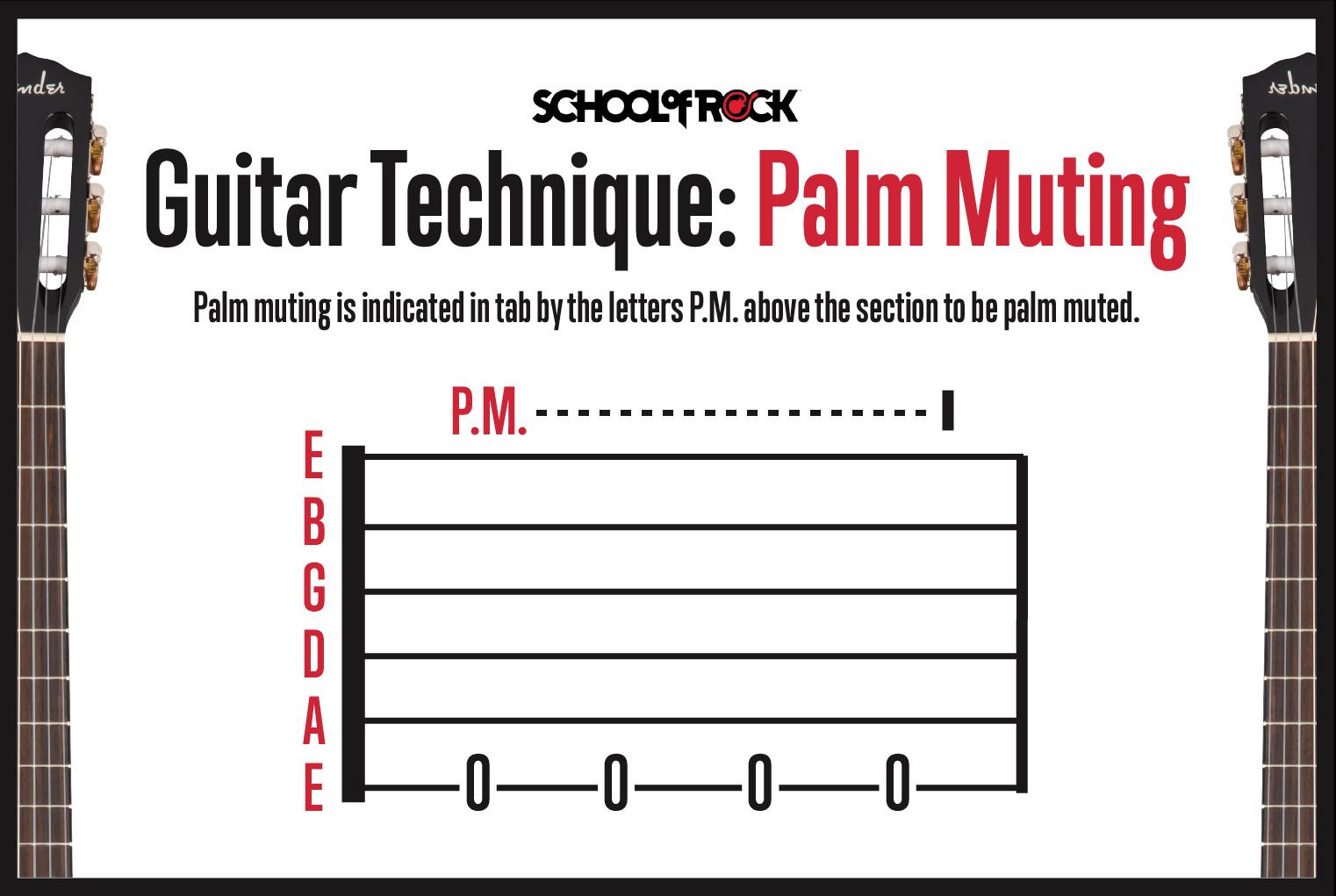 Palm Muting Technique: Picking Hand Control
Palm Muting Technique: Picking Hand Control
MUTED NOTES: The Fretting Hand Approach
Muted notes are distinct from palm muting and are achieved using the fretting hand. In this technique, the strings are picked, but the fretting hand only lightly touches the strings, preventing them from ringing out clearly. In guitar tablature, muted notes are represented by an “X” in place of a fret number.
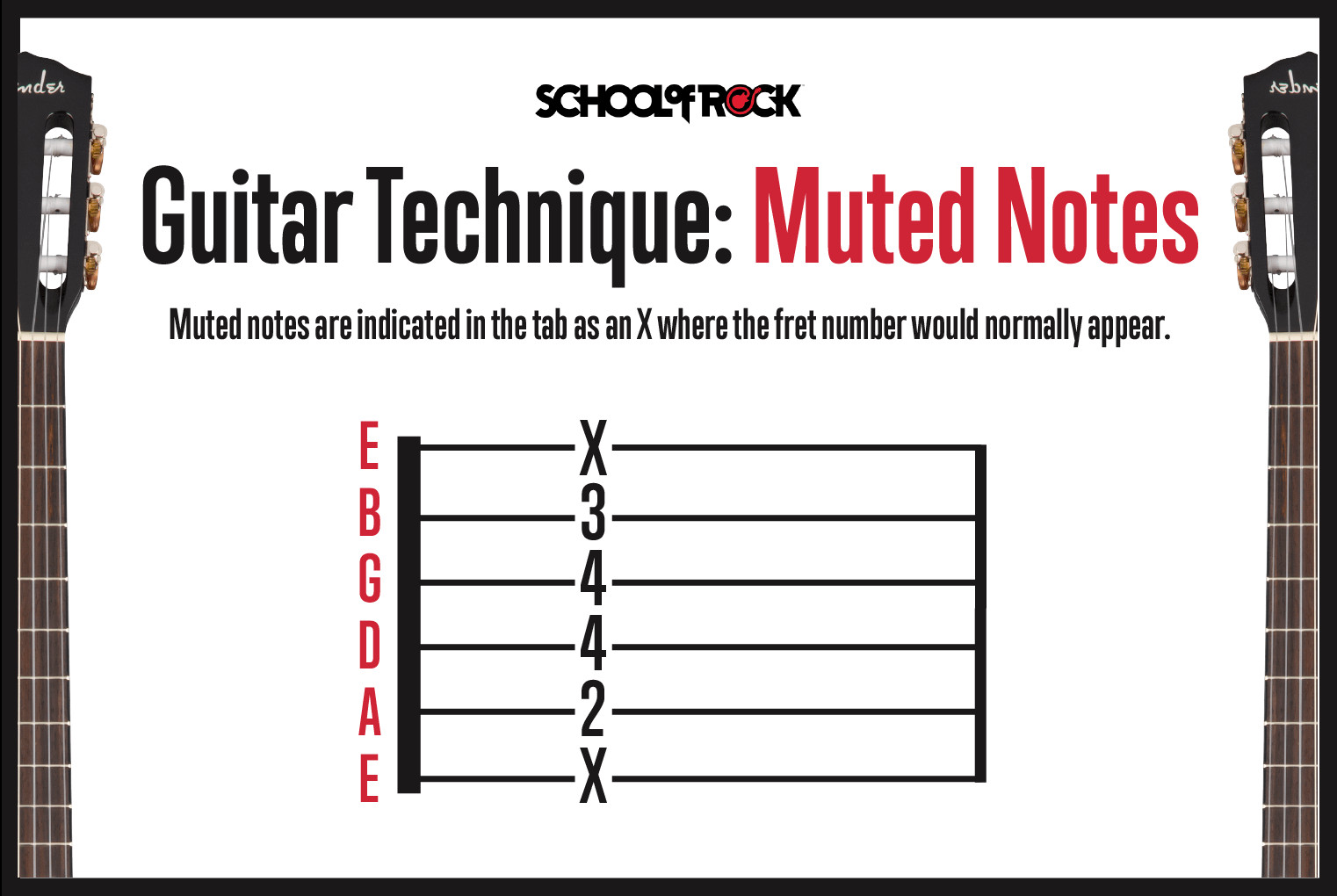 Muted Notes Technique: Fretting Hand Light Touch
Muted Notes Technique: Fretting Hand Light Touch
BENDING GUITAR STRINGS: Adding Vocal Expression
String bending is a powerful technique that adds an expressive, vocal-like quality to guitar playing. In guitar tabs, bends are indicated by a curved arrow above the note. This arrow signifies that you should manipulate the string to raise its pitch. The arrow may specify a “½” or “full” step, instructing you to bend the string up by one semitone (half step) or two semitones (full step). These target pitches are often referred to as “target notes.”
HOW TO EXECUTE STRING BENDS
String bending involves pushing the strings up or down the fretboard, rather than pressing directly down onto the fret. For most strings, excluding the low E, players typically push upwards towards the ceiling. The low E string is usually bent downwards towards the floor. The key to a good bend is applying smooth, consistent pressure throughout the bend.
BENDING TECHNIQUE: Finger Support and Control
Most bends are executed using 2 or 3 fingers for added strength and control. The primary fretting finger (often the ring finger) is supported by the middle and index fingers. This multi-finger approach results in smoother bends and greater accuracy in reaching the desired pitch.
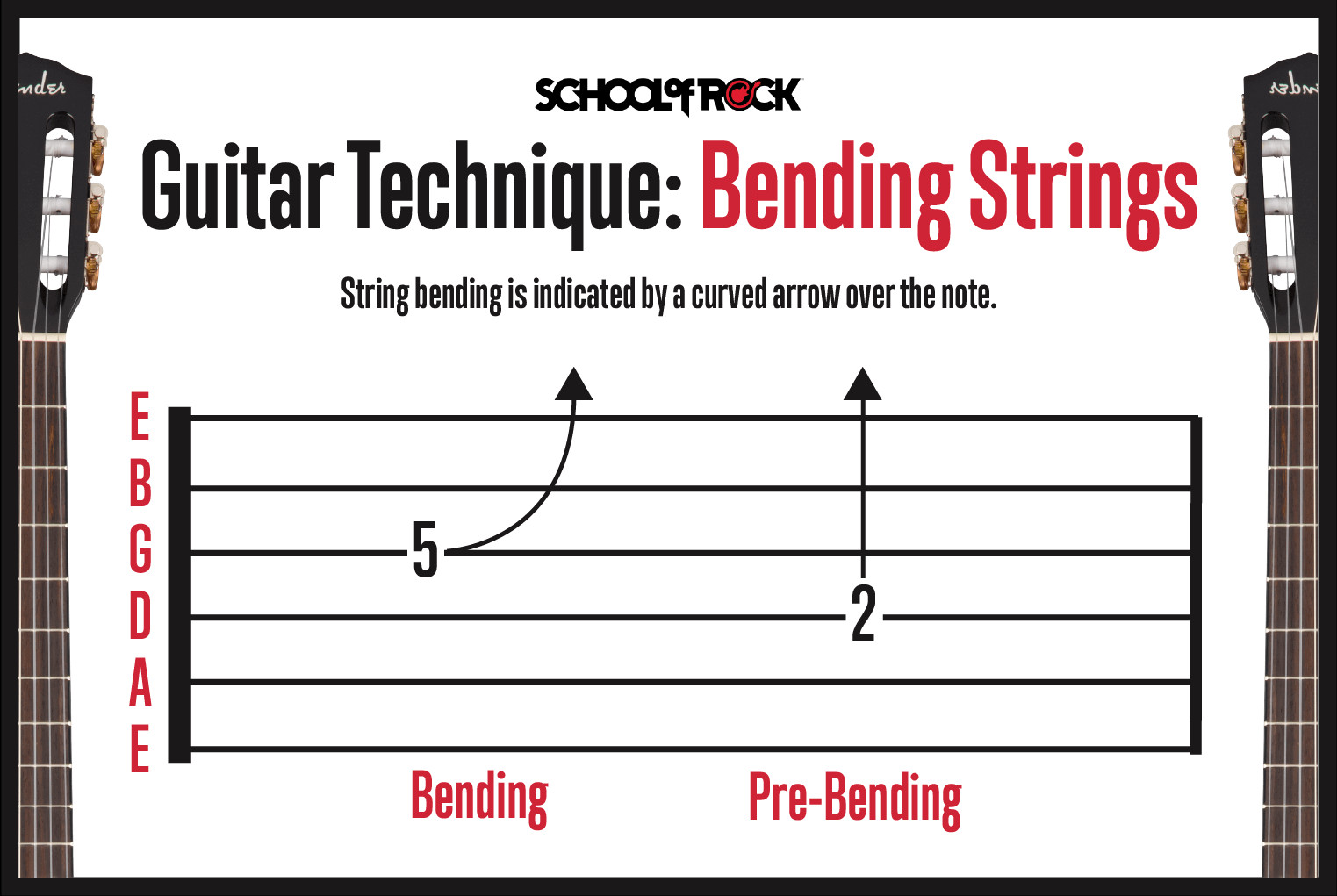 String Bending Technique: Multi-Finger Support
String Bending Technique: Multi-Finger Support
PRE-BENDING: Anticipating the Bend
Beginners learning how to read guitar tabs might encounter “pre-bends.” In a pre-bend, the string is bent to the target pitch before being picked. The string is then picked and often released, returning to the original fretted note’s pitch. Pre-bends are notated by an upward arrow indicating the bend amount (full, ½, etc.), followed by a downward curved arrow to show the release. Pre-bent notes can resolve back to the original pitch or bend further upwards to a different target note.
SLIDING GUITAR NOTES: Smooth Transitions
Sliding is another essential technique for seamless transitions between notes. You can slide upwards to a higher note or downwards to a lower note. Sliding differs from bending because you maintain contact with the string while moving your fretting finger along the fretboard.
SLIDE UP TECHNIQUE
An upward slide in guitar tab is represented by a line connecting the starting note to the destination note. If the slide is to a higher-pitched note, the connecting line will often angle slightly upwards.
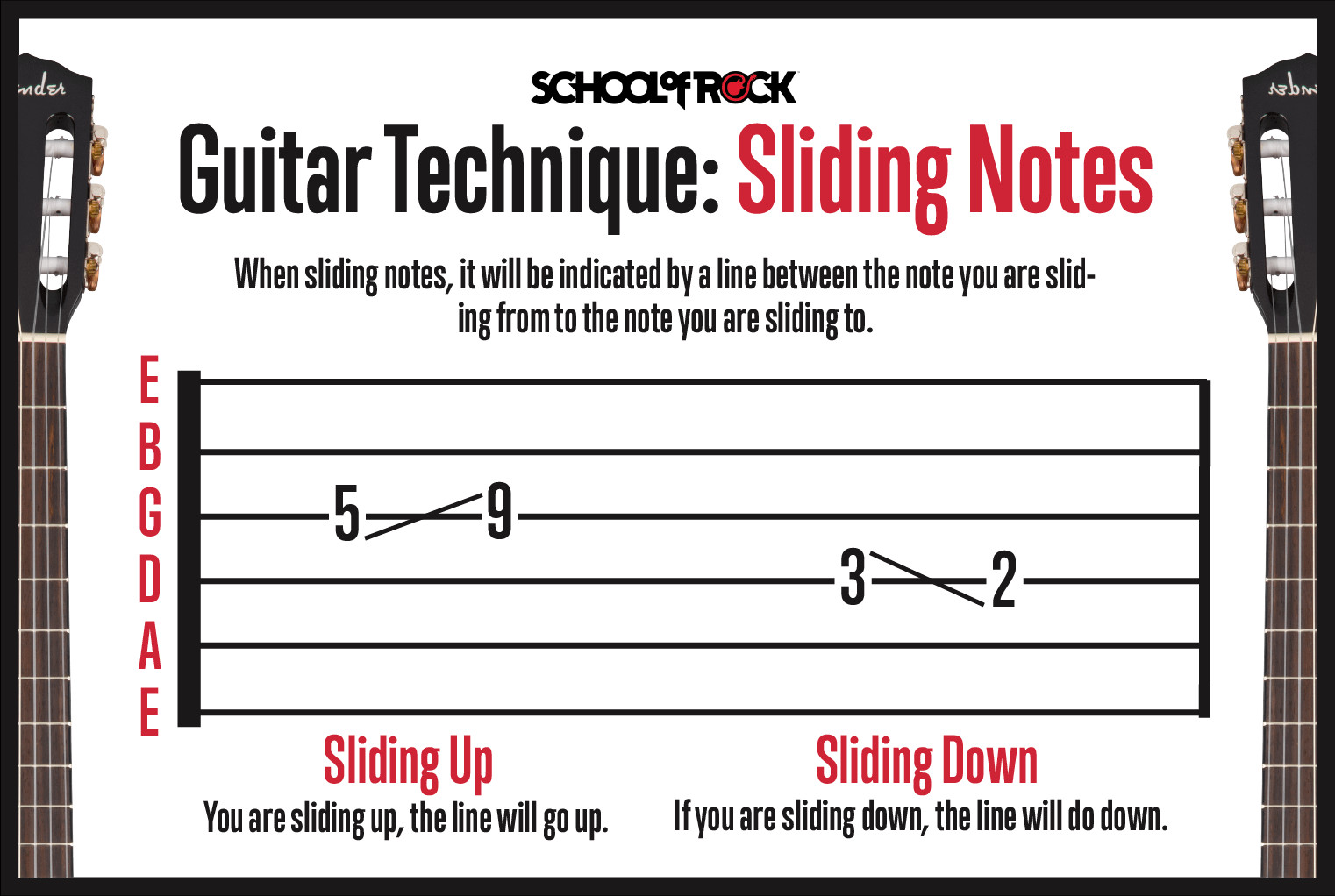 Slide Up Technique: Moving to a Higher Note
Slide Up Technique: Moving to a Higher Note
SLIDE DOWN TECHNIQUE
Conversely, a downward slide is also shown by a line between notes. If the slide is to a lower pitch, the line may angle slightly downwards.
HAMMER-ONS: Articulating Notes with the Fretting Hand
The hammer-on is a technique where you articulate a note solely with your fretting hand, without picking the string again. You “hammer-on” a fretting finger onto the string, causing it to sound. Hammer-ons can originate from an open string or a previously fretted note, always resulting in a higher-pitched note. Hammer-ons are notated in guitar tabs with an “H” and a curved arc connecting either an open string to the hammered-on note or a fretted note to the hammer-on note.
HOW TO PERFORM HAMMER-ONS
To execute a hammer-on, strike the string with your fretting finger with enough force to produce a clear note. This takes practice to develop sufficient finger strength and articulation. Hammer-ons are often easier to execute on electric guitars, especially at higher volumes. Practice by starting with an open low E string and hammer-on to the third fret, sustaining the note. Repeat this exercise on different strings and frets to build proficiency.
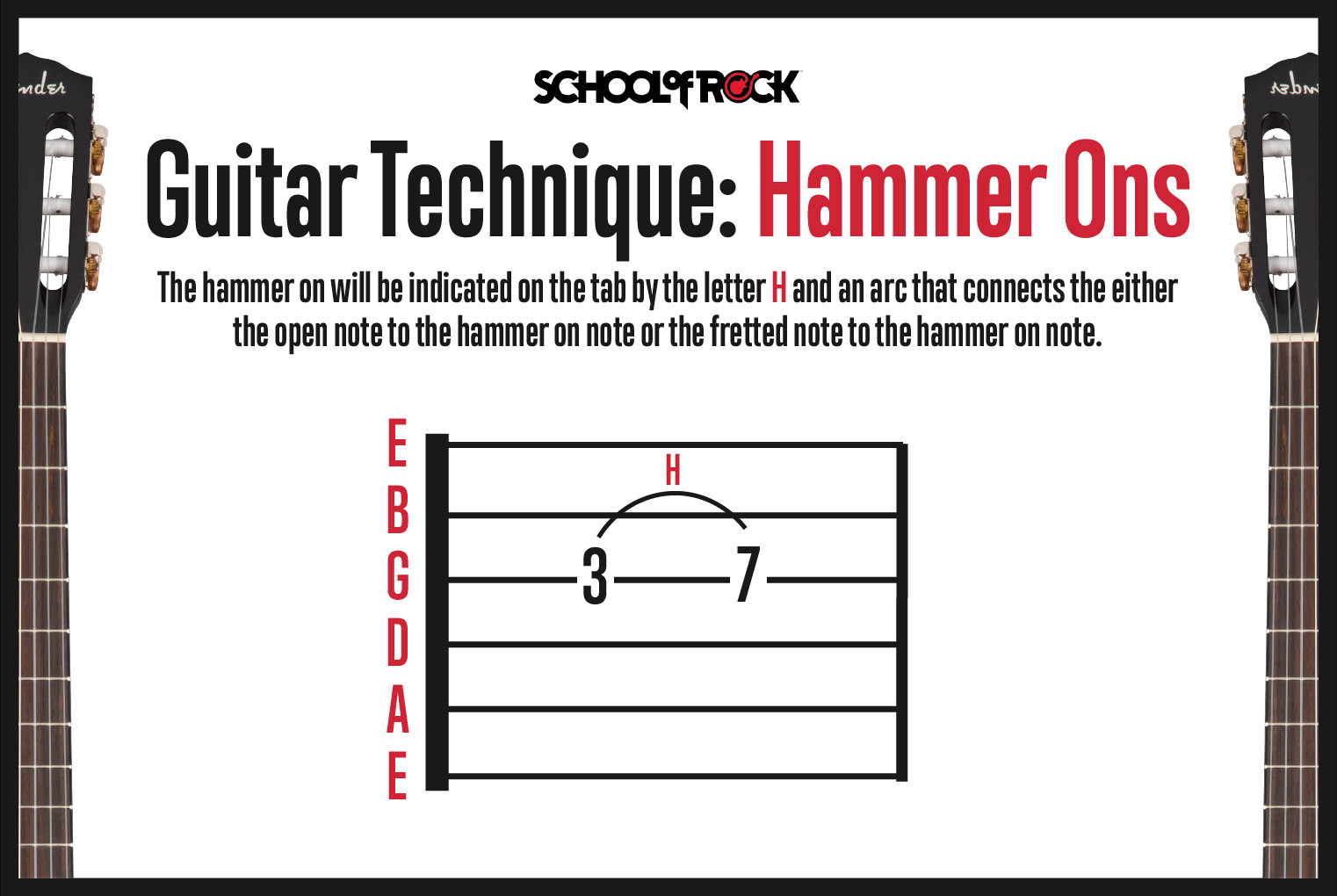 Hammer-On Technique: Fretting Hand Articulation
Hammer-On Technique: Fretting Hand Articulation
PULL-OFFS: Releasing to a Lower Pitch
Pull-offs are the inverse of hammer-ons. Instead of hammering onto a string, you “pull-off” a fretted finger to sound either an open string or a lower-fretted note. Pull-offs are represented in guitar tabs by a “P” and a curved arc connecting the pulled-off note to the resulting lower note.
HOW TO PERFORM PULL-OFFS
To perform a pull-off, fret a note and then pull your finger off the string in a sideways and downwards motion, plucking the string as you release. This action sounds either an open string (if pulling off to an open string) or a lower-fretted note (if pulling off to another fretted finger). When executing pull-offs, ensure you “grab” enough of the string with your fingertip to produce a clear sound as you pull off.
Hammer-ons and pull-offs can be combined in rapid alternation, creating a technique often called a “trill.”
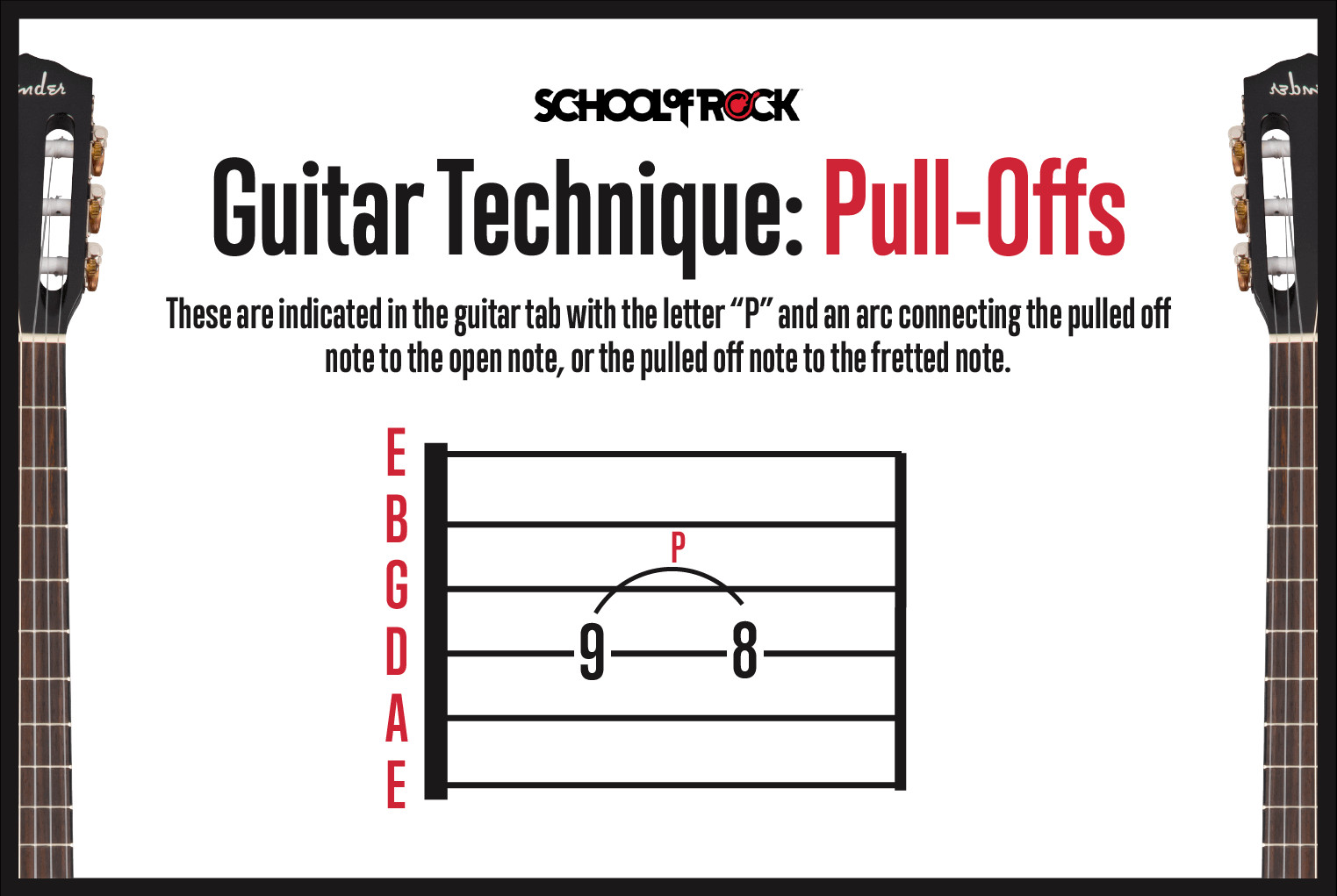 Pull-Off Technique: Releasing to a Lower Note
Pull-Off Technique: Releasing to a Lower Note
VIBRATO: Adding Sustained Expression
Vibrato is a technique that adds warmth and expressiveness to sustained notes. It involves repeatedly bending a note slightly and releasing it back to the original pitch without lifting your finger from the fret. Vibrato is indicated in guitar tabs by a zig-zag line above the staff. The length of the zig-zag line generally corresponds to the duration of the vibrato.
HOW TO PERFORM VIBRATO
Vibrato is similar to bending, but with a much smaller pitch variation. You can apply vibrato using a single finger or by using a primary finger supported by others. Start practicing with a slow, smooth vibrato and gradually vary the speed to create different expressive effects. Like bending, vibrato adds a vocal quality to solos, and every guitarist develops a unique vibrato style, as individual as a fingerprint.
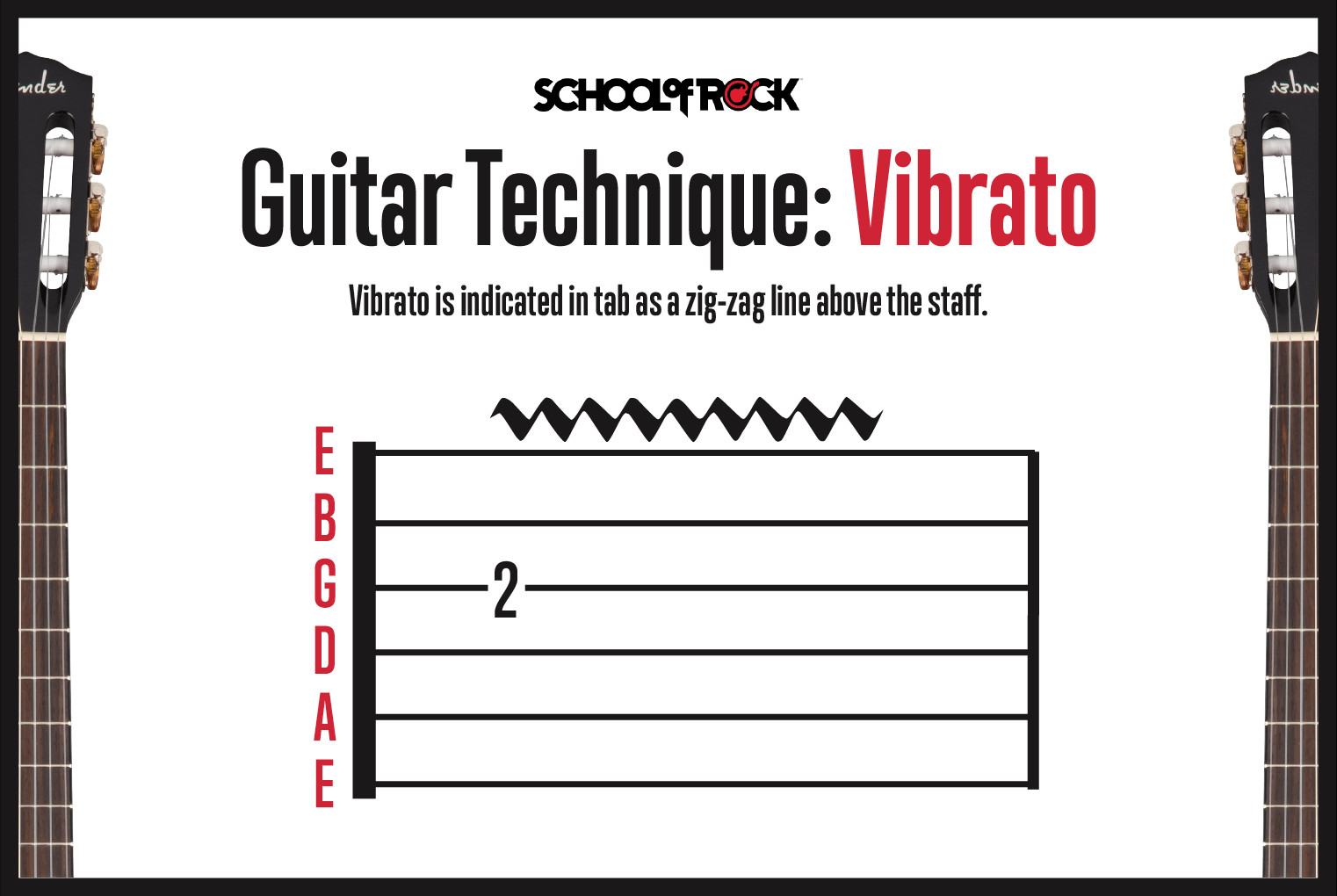 Vibrato Technique: Sustained Note Modulation
Vibrato Technique: Sustained Note Modulation
TAPPING: Two-Handed Fretboard Articulation
Tapping is an advanced technique involving fretting notes with your regular fretting hand while simultaneously “tapping” notes on the fretboard with a finger from your picking hand, usually the index finger. Picking-hand tapping is essentially a variation of a hammer-on. Tapping is notated in guitar tabs with a “T” above the tapped note.
HOW TO FINGER TAP
Tapping was popularized by Eddie Van Halen, but the technique has roots in classical guitar. To finger tap, fret a note with your fretting hand and then tap a higher note on the same string with your picking hand’s index finger.
Finger tapping expands upon the hammer-on concept, utilizing your picking hand to fret notes. This allows you to play notes with intervals too wide to reach with just your fretting hand.
Playing with higher gain and volume often enhances the effectiveness and sound of tapping. Tapping enables very fast playing as you are effectively fretting notes with both hands.
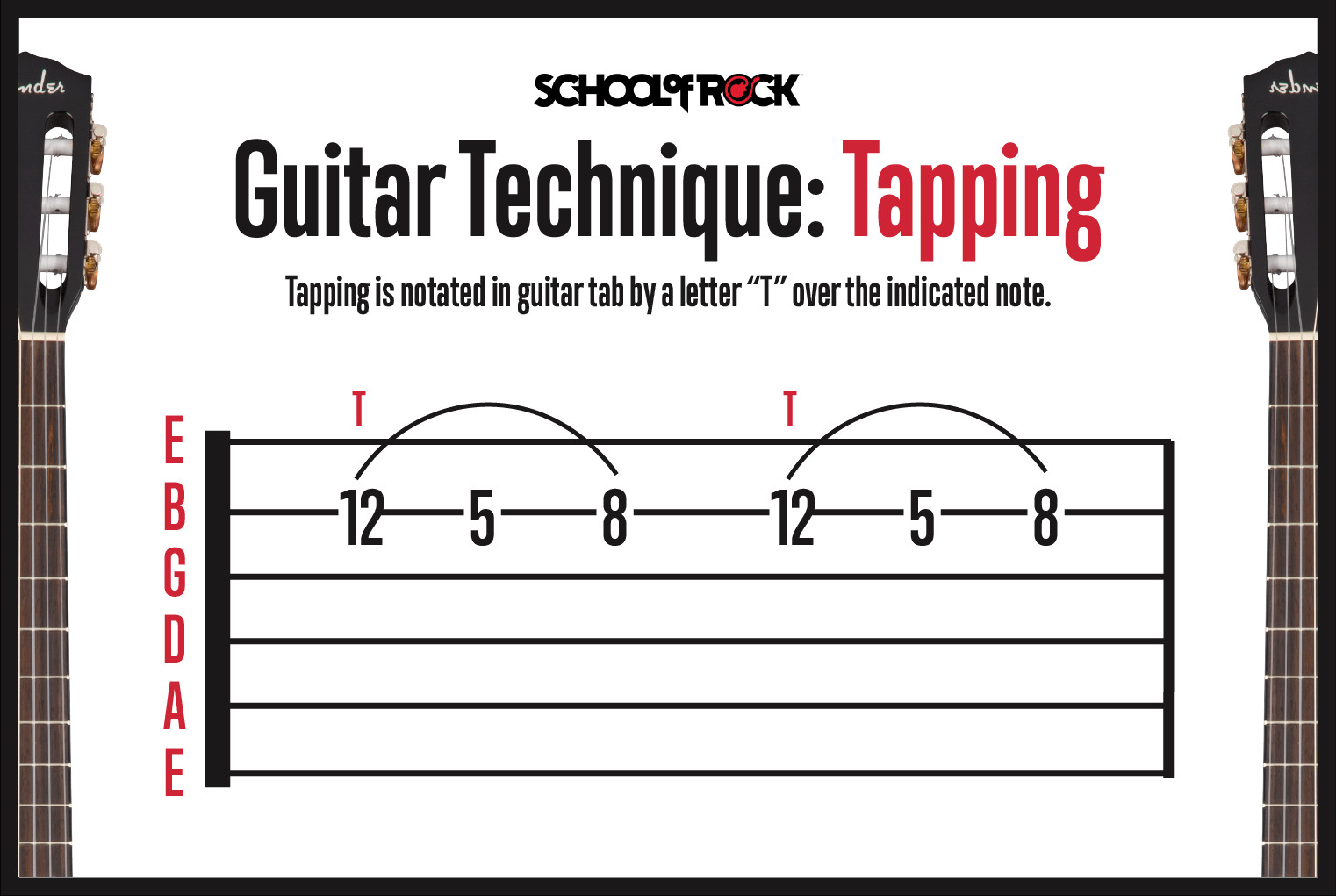 Tapping Technique: Two-Handed Fretboard Use
Tapping Technique: Two-Handed Fretboard Use
TWO-HANDED TAPPING: Independent Lines
Two-handed tapping takes the concept further, with both hands independently hammering-on notes without traditional picking. This can involve the fretting hand tapping bass notes while the picking hand taps melody or solo lines, creating complex textures.
STRUMMING GUITAR NOTES: Rhythm and Chords
Strumming chords involves two fundamental picking motions: downstrokes and upstrokes.
Downstrokes begin on the lower strings and finish on the higher strings, using a downward motion. In guitar tabs, downstrokes are represented by a symbol resembling a thick horizontal line with two short vertical “legs” pointing downwards on either side.
Upstrokes are the opposite, starting on the higher strings and ending on the lower strings with an upward motion. Upstrokes are notated in guitar tablature with a “V” shaped symbol.
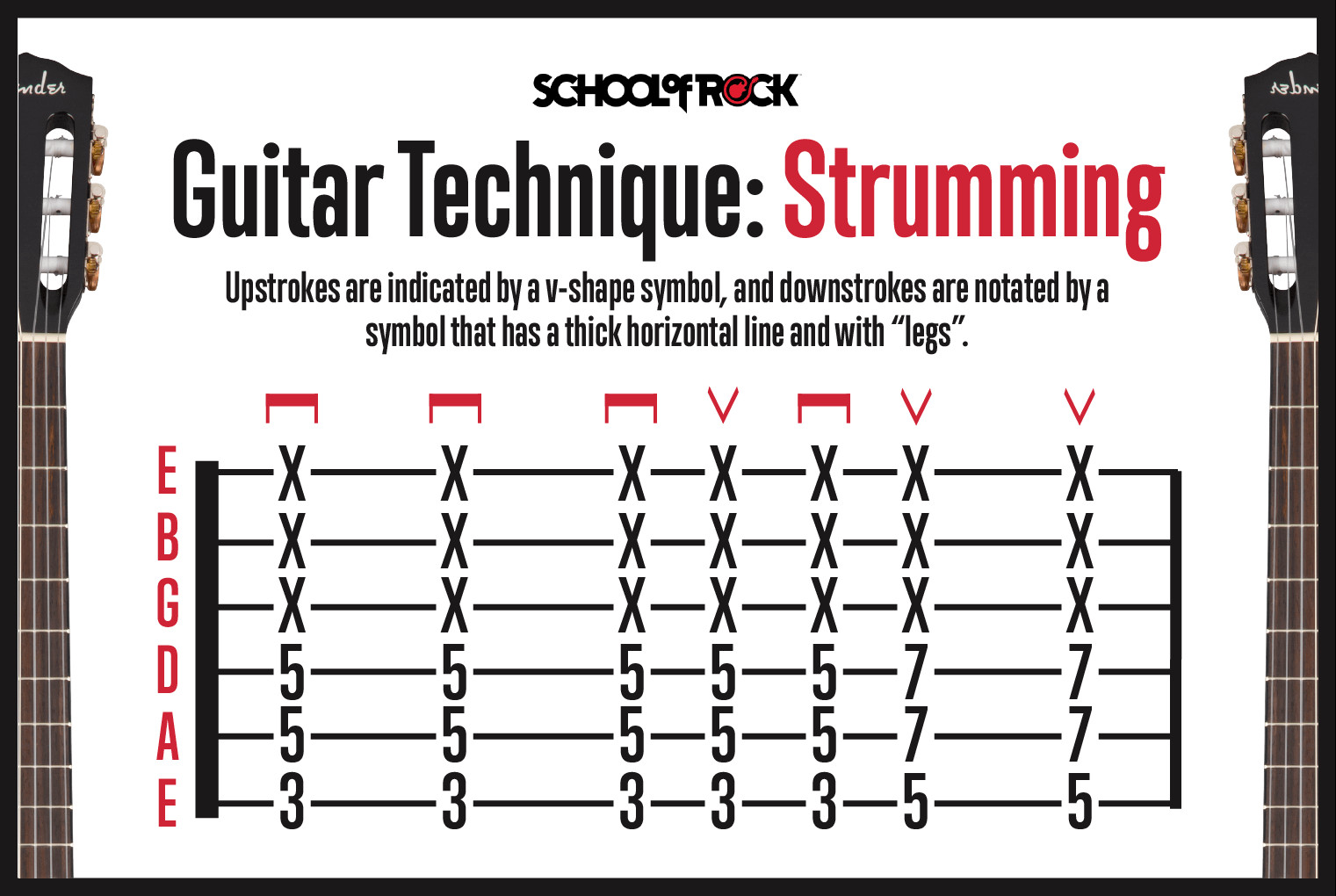 Strumming Technique: Downstrokes and Upstrokes
Strumming Technique: Downstrokes and Upstrokes
HOW TO STRUM EFFECTIVELY
Various strumming patterns are used depending on the song’s rhythm. You can strum with a constant down-up pattern or any combination of downstrokes and upstrokes. Songs with eighth-note rhythms are often counted as “one and two and three and four and…” Many songs utilize alternating downstrokes (on the numbered beats) and upstrokes (on the “ands”) in an eighth-note rhythm.
DOWNSTROKES AND UPSTROKES FOR SINGLE NOTES
The same downstroke and upstroke notation applies even when playing single notes in guitar tabs. Downstrokes (horizontal bar with legs) indicate a downward pick motion, and upstrokes (V symbol) indicate an upward pick motion.
READY TO EXPLORE MORE GUITAR TECHNIQUES?
Now that you’ve learned how to read guitar tabs and understand common guitar techniques, you’re well-equipped to start playing! From beginner fundamentals to advanced techniques, guitarplayers.net is dedicated to helping guitarists of all levels reach their full potential. From strumming to tapping and beyond, our resources are here to guide you on your musical journey.
Eager to find guitar tabs? From easy beginner songs to challenging pieces for experienced players, guitarplayers.net is your resource. Explore a wide selection of sheet music and tabs to fuel your guitar playing.
Thinking about a new guitar? Check out our Guitar Buying Guide for essential tips!

